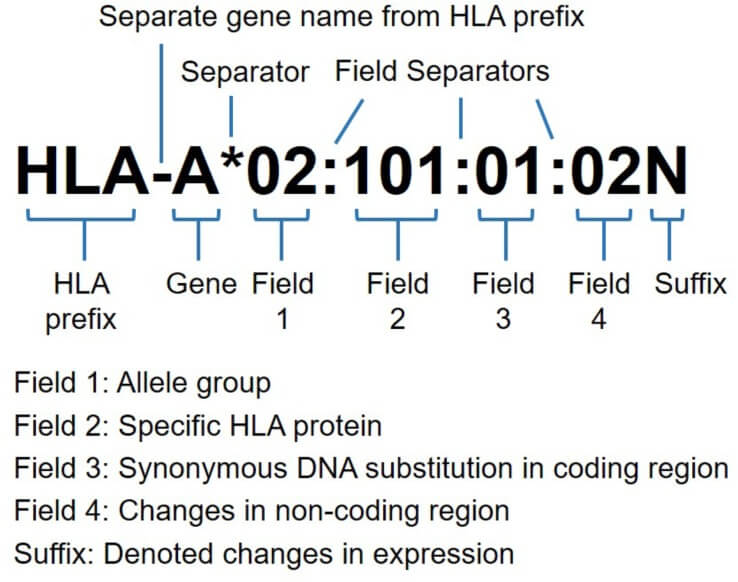Detection of human leukocyte antigen (HLA) can provide important reference information for the treatment of immune diseases. However, to obtain high-resolution HLA typing results through conventional methods generally requires multiple analyses, systems, and analytical procedures. Creative Biolabs can perform HLA typing by Next-Generation Sequencing (NGS), generates unambiguous, phase-resolved results using a single assay, system, and analysis program.
The HLA complex is the most polymorphic genetic system in the human genome and is located in the 6P21.31 region of the short arm of chromosome 6, which is 3,600 kb long. In 1999, all sequence analysis and gene mapping were completed. A total of 128 of the 224 loci were identified as functional genes in this region, of which 39.8% were related to immune function. The DNA sequence of many gene seats in the HLA complex has many variants in the population, that is, HLA contains a large number of alleles. Because the odds of parents having all the same HLA genes on chromosome 6 are small, each individual inherits different HLA genes and their products. HLA allele frequency is not only significantly different in different populations and regions but also correlated with some diseases. HLA typing provides an effective means for organ transplantation recipients and selection, and is also used in forensic DNA typing and paternity testing. Therefore, HLA typing not only provides important scientific data for understanding ethnic origin and migration but also plays an important role in medical practice. However, high HLA polymorphism also makes it difficult to find suitable donors for organ transplantation.
Since the advent of PCR, DNA-based HLA typing technology has made significant progress. DNA typing can achieve higher HLA resolution and therefore has a better diagnostic effect than serotyping. It has become the standard procedure in many clinical applications, especially for hematopoietic stem cell transplantation (HSCT) matching, and helps to study the role of HLA in the pathophysiology of disease. The application of NGS for HLA typing first requires PCR amplification of target genes on the genome, quantitative purification and connection to indexed adaptors to prepare the library, and finally NGS platform for sequencing and analysis of the results. The combined approach of NGS based advanced methods for increased sequence lengths and advanced bioinformatics tools has potentially emerged as the gold standard for accurate typing of HLA variants and generation of full-length HLA haplotypes without phase ambiguity.
By accurately identifying the association between HLA and disease at the allele level, and using accurate data from NGS-based population genetics studies, Creative Biolabs' NGS technology service provides a comprehensive and definitive examination of the wide range of polymorphisms in HLA regions, which will help customers advance the field of HLA and disease research. We believe that NGS, with its high throughput, scalability, and speed, enables researchers to perform a variety of applications and research biological systems at unprecedented levels.
If you have any questions about our vector design service, you can contact us by email or send us an inquiry to find a complete solution.
Other optional ECIA™ HLA tissue typing service:
 Fig. 1 HLA nomenclature with allele resolution at four fields (eight digits). (Amit Kishore, 2018)
Fig. 1 HLA nomenclature with allele resolution at four fields (eight digits). (Amit Kishore, 2018)
The article explores the use of Next-Generation Sequencing (NGS) for HLA typing in investigating the immunogenetic factors of sarcoidosis. This condition, often marked by complex immunological reactions, has known associations with various HLA alleles, but previous studies using less precise technologies have only hinted at these links. By applying NGS, the study achieves high-resolution typing of HLA genes, enabling a more detailed and accurate assessment of HLA allele variations and their potential influence on sarcoidosis. The use of NGS allows for a comprehensive analysis of both coding and non-coding regions of the HLA complex, which is crucial for understanding the nuanced immunogenetic contributions to sarcoidosis and potentially improving diagnosis and treatment strategies.
NGS-based HLA typing is a method that uses high-throughput sequencing technologies to determine the types of human leukocyte antigen (HLA) genes at a high resolution. Unlike traditional methods, NGS can sequence entire HLA genes in a single run, providing detailed insights into the genetic variations and alleles present.
NGS-based HLA typing improves transplant outcomes by enabling more precise matches between donors and recipients. By identifying minor differences in HLA alleles, NGS reduces the risk of transplant rejection and graft-versus-host disease, leading to better long-term survival rates and fewer complications.
NGS-based HLA typing can detect nearly all types of HLA alleles, including many that are rare or newly characterized. Its comprehensive sequencing capability allows it to identify variations across the entire gene, making it one of the most thorough methods available for HLA typing.
Initially, NGS-based HLA typing was more expensive than traditional methods. However, as sequencing technologies have advanced and become more widespread, the costs have decreased significantly. Now, NGS offers a cost-effective solution when considering its benefits in reducing post-transplant complications and the need for re-transplantation.
The turnaround time for NGS-based HLA typing can vary but typically ranges from a few days to a week. This timeframe includes sample preparation, sequencing, and the complex data analysis needed to determine HLA types from the sequencing results.
Use the resources in our library to help you understand your options and make critical decisions for your study.
All listed services and products are For Research Use Only. Do Not use in any diagnostic or therapeutic applications.
| USA:
Europe: Germany: |
|
|
Call us at: USA: UK: Germany: |
|
|
Fax:
|
|
| Email: info@creative-biolabs.com |
